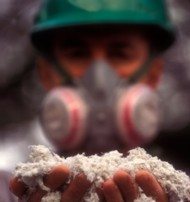Flaxseed Compound May Help Prevent Malignant Mesothelioma and Asbestosis

There is new evidence that a compound found in flaxseeds may help prevent malignant mesothelioma and other asbestos-related diseases.
The compound is an anti-inflammatory which appears to calm down the overactive immune system after asbestos exposure in mice.
Inflammation has long been considered a key factor in the development of mesothelioma. Scientists are hopeful that preventing it may also prevent malignant mesothelioma.
Inflammatory Response to Asbestos Exposure
Asbestos is a group of naturally-occuring minerals that cause cancer in people and animals.
When a person accidentally breathes in or swallows asbestos fibers, they trigger an inflammatory response that can last for years.
White blood cells flock to the area and damaging free radicals are produced. Over time, some cells may become cancerous. There is no known way to prevent malignant mesothelioma or other asbestos diseases once this process has started.
Libby, Montana was home to a vermiculite mining operation that was contaminated with amphibole asbestos. An estimated 400 Libby residents have died and thousands more are sick because they could not prevent malignant mesothelioma after exposure to these fibers.
Can Flaxseeds Prevent Malignant Mesothelioma?
Secoisolariciresinol diglucoside (SDG) is a powerful anti-inflammatory compound found in flaxseeds. It also has anti-fibrotic and antioxidant properties.
In a new study, University of Pennsylvania researchers gave a synthetic form of SDG (called LGM2605) to mice three days before they infected them with Libby amphibole (LA) asbestos fibers. The goal was to prevent malignant mesothelioma by modulating the inflammatory response.
The mice continued to get daily doses of SDG for three days after exposure. On the third day, researchers checked them again.
“LGM2605 reduced LA-induced acute inflammation and white blood cell trafficking supporting its possible use in mitigating downstream LA fiber-associated diseases,” writes lead author Melpo Christofidou-Solomidou, PhD.
The team ran a similar study on crocidolite asbestos. That study found that synthetic SDG had “potent protective properties” against peritoneal mesothelioma in these mice, too.
Since there is no known way to keep mesothelioma tumors from forming in humans, asbestos-exposed people should know the symptoms and have regular check-ups.
Some studies suggest that regular CT screening may help prevent malignant mesothelioma deaths by picking up signs before symptoms develop.
Source:
Christofidou-Solomidou, M, et al, “Synthetic secoisolariciresinol diglucoside (LGM2605) inhibits Libby amphibole fiber-induced acute inflammation in mice”, April 22, 2019, Toxicology and Applied Pharmacology, Epub ahead of print, https://www.sciencedirect.com/science/article/pii/S0041008X19301504?via%3Dihub





